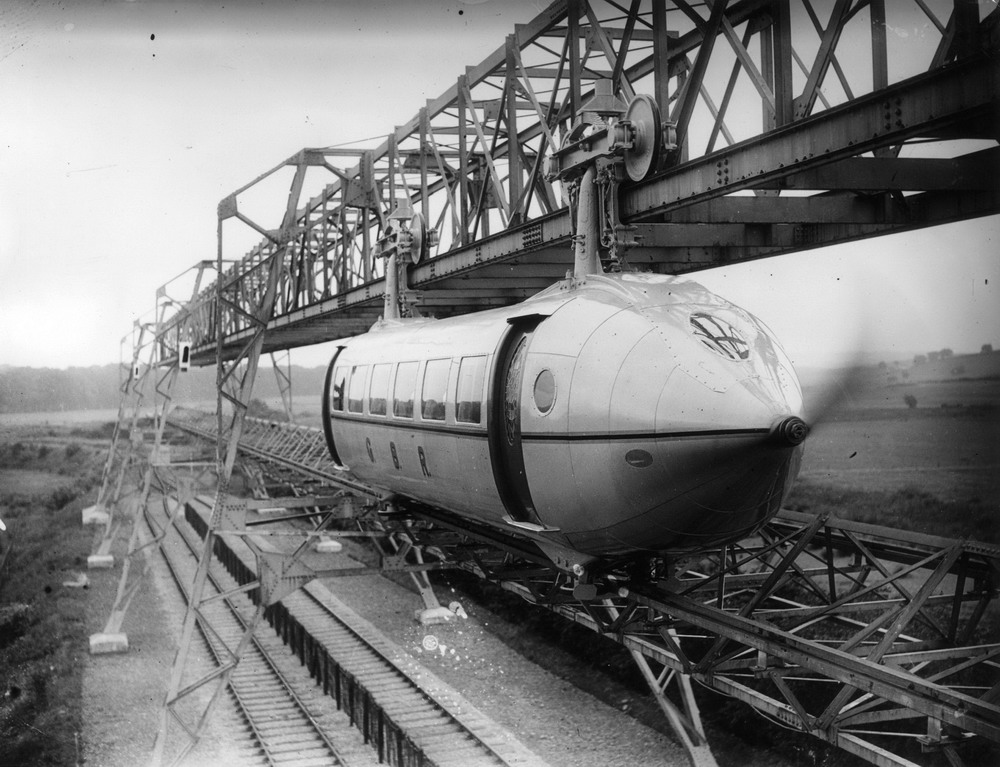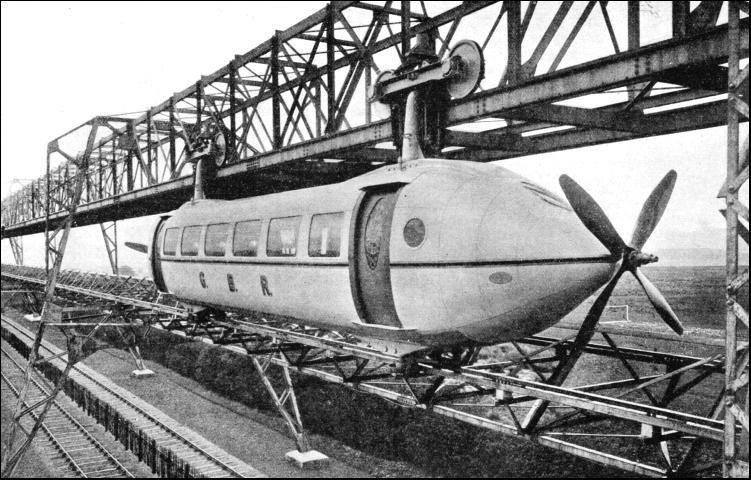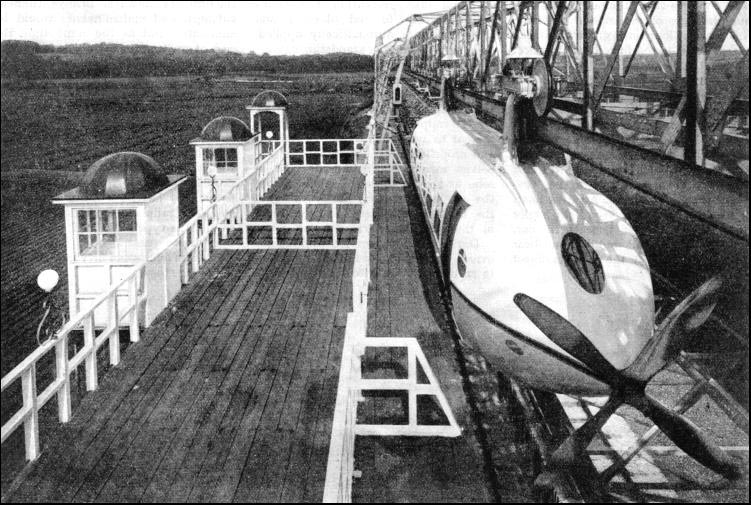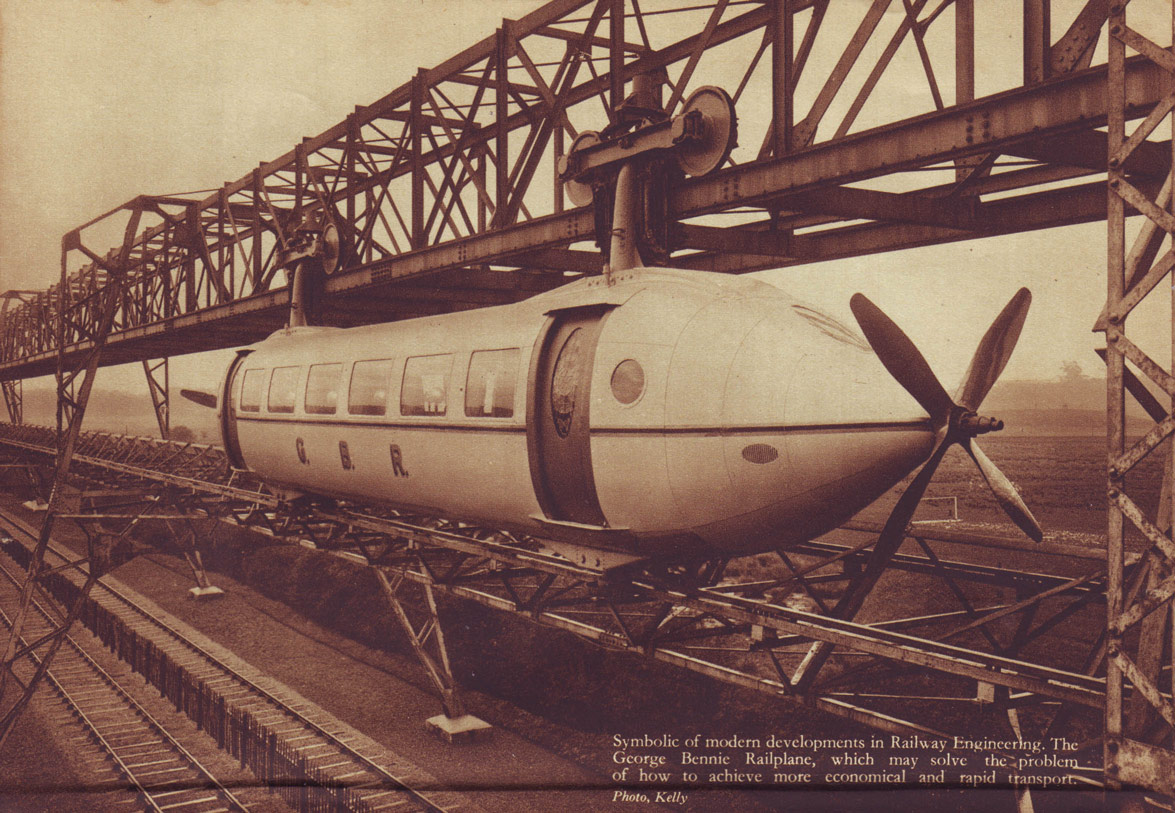Sam
TS Member
I have an announcement. From this morning, I am no longer a rollercoaster enthusiast. I am a Bennie Railplane enthusiast. 'Ahh Sam, but how can you give up your greatest passion and love in life?' I hear you ask in my head. Well, you wait until you see this...
The Bennie Railplane
The Railplane was an experimental mode of transport invented in 1921 by George Bennie. It was sort of like a suspended monorail that ran directly over train tracks, kinda like the Schwebebahn at Wuppertal. The idea of it was to relieve congestion on the railways. Slow moving freight trains would use the normal railway track below, while passengers would travel on the futuristic monoplane above.

In 1930, Bennie built a quarter of a mile of test track on the outskirts of Glasgow, and began running regular demonstrations. Travelling on the Railplane were the gorgeous monoplanes, powered by electricity and capable of reaching 120mph. If proposals to build a Railplane between Glasgow and Edinburgh had not fallen through, the journey time between the two cities would have been cut to a half hour.

Unfortunately for Bennie, the Great Depression had just kicked in, and the Second World War was not far away. People lost interest in his expensive Railplane, and the project was eventually abandoned. He tried to revive the idea after the war, but to no avail. The quarter of a mile of track, and a fully working monocar sat abandoned until the track was torn down in the mid fifties for scrap. Bennie died in 1957, penniless.

His bizarre and beautiful transport system was never developed. I can't quite believe, and am slightly ashamed frankly, that I've never heard of this fascinating story before. But now I've become a bit obsessed with George Bennie and the Railplane. Here's the article that I read first, that I took the facts above from. It also includes a fascinating account of a illicit journey on the abandoned Railplane in the 50s.
Engrossing stuff.
The Bennie Railplane
The Railplane was an experimental mode of transport invented in 1921 by George Bennie. It was sort of like a suspended monorail that ran directly over train tracks, kinda like the Schwebebahn at Wuppertal. The idea of it was to relieve congestion on the railways. Slow moving freight trains would use the normal railway track below, while passengers would travel on the futuristic monoplane above.

In 1930, Bennie built a quarter of a mile of test track on the outskirts of Glasgow, and began running regular demonstrations. Travelling on the Railplane were the gorgeous monoplanes, powered by electricity and capable of reaching 120mph. If proposals to build a Railplane between Glasgow and Edinburgh had not fallen through, the journey time between the two cities would have been cut to a half hour.

Unfortunately for Bennie, the Great Depression had just kicked in, and the Second World War was not far away. People lost interest in his expensive Railplane, and the project was eventually abandoned. He tried to revive the idea after the war, but to no avail. The quarter of a mile of track, and a fully working monocar sat abandoned until the track was torn down in the mid fifties for scrap. Bennie died in 1957, penniless.

His bizarre and beautiful transport system was never developed. I can't quite believe, and am slightly ashamed frankly, that I've never heard of this fascinating story before. But now I've become a bit obsessed with George Bennie and the Railplane. Here's the article that I read first, that I took the facts above from. It also includes a fascinating account of a illicit journey on the abandoned Railplane in the 50s.
Gear Wheels Mag said:The Bennie Railplane
Fifty years ago some thought that by the beginning of the third millennium we would all be travelling by high-speed monorail. It hasn't happened yet, but it wasn't for any lack of effort by British engineer and
inventor George Bennie in the first half of the 20th century with his novel overhead Railplane. These days we take air travel for granted, but this was not always so. I was reminded of this on a visit to Southport on Merseyside, home of one, if not the best boys' comic of all time, The Eagle.
Founded by a clergyman, Marcus Chambers, in the early 1950s, its main feature on the opening pages was 'Dan Dare, Pilot of the Future', and this is commemorated by a bronze bust of the aforementioned comic strip character, together with a plaque, in Southport's main shopping centre. To some of a certain vintage this may conjure up visions of the evil Mekon, space ships, novel gadgets and strange methods of transportation - all, of course, flowing from the fertile mind of their creator, Frank Hampson. One of the latter futuristic modes of travel was the monorail.
A flash back to the mid-Fifties reminded me of a visit with a scout troop to a camp near Glasgow. On one outing we came across something which could have come straight from the pen of Hampson for, glistening in the sunlight, and despite its age and condition, was an object shaped like an aircraft fuselage (it even had a propeller mounted at the front and rear end) suspended from a single overhead rail. It was what we later discovered to be the Bennie Railplane, an innovative transport system.
However, monorails, even in 1955, were not new. As far back as 1825 the first passenger carrying overhead railway was in use (albeit horse drawn) at Cheshunt in Hertfordshire and based on a patent taken out in 1821 by one Henry Robinson Palmer. But it was to be another half century before a steam-driven monorail was demonstrated at the US Centennial Exposition and not until 1888 that the 91/2-mile Listowel & Ballybunnion system (also steam operated) was opened on the west coast of Ireland. There was even a gyroscopic monorail demonstrated to the military in 1909 at Gillingham, designed by Louis Brennan; but of course, the best-known monorail which is still in existence and in everyday use is the Barmen-Elberfeld swinging railway at Wuppertal in Germany which was opened in 1898.
But without a doubt and arguably the most exciting and futuristic proposal was the one patented and built by George Bennie. The beautifully streamlined monorail coach was powered by two electric motors drawing power from the local tram grid to produce a continuous 60 brake horse power, with 30 second bursts of up to 240 b.h.p. Each motor drove a separate four-bladed airscrew/ propeller positioned at either end of the fuselage to give a projected cruising speed of up to 120 miles per hour.
Mounted on a rigid overhead structure, the system neatly combined the safety of rail travel - it was dubbed 'Railplane' from the very beginning - with something like the speed of an air travel, but with none of the problems later associated with the latter. Furthermore, by constructing the monorail over existing railway tracks, costs and some other environmental considerations would have been kept to a minimum to produce an effective and highly efficient transportation system with the secondary benefit of separating fast passenger traffic from slow moving freight trains.
The capsule was suspended from the steel trestles on two bogies mounted on laminated springs with a 'swayframe' structure beneath to act as a guide, but bearing no actual weight. A set of locating wheels were employed underneath to take up undue swaying on curves due to centrifugal forces. With the railcar being propelled by airscrews, it's tare weight, or total weight before passengers, goods, etc., was low and adhesion did not enter into the tractive-effort calculations.
But the real genius in the design was the `lifting-plane' (or wing airfoils) at either end to give lift. To quote Bennie's patent application dated September 1921: `As the speed of the craft increases, the weight of the same is gradually transferred from the rail to the planes so that any tendency of the craft to rise can be overcome by adjustment of the lifting planes'. Heady stuff for the early Twenties, but the basic principle that keeps aeroplanes aloft and the adverse to that used to keep modern Formula 1 cars in contact with the ground. Gradients as steep as 1 in 25 would be negotiated with ease due to no wheel adhesion being necessary - leaves on the 'line' would never be a problem!
In 1929/30 a short experimental track of approximately a quarter of a mile in length was built by The Teeside Bridge & Engineering Works at Milngavie on the outskirts of Glasgow. George Bennie gave many demonstrations with interest running high at the time and proposals were put forward to link the aforementioned city with Edinburgh, a journey which could have been completed in less than half an hour. Southern Railways also expressed interest in a London to Croydon Aerodrome link.
But the Thirties were the wrong time for such advanced ideas. Finance was extremely difficult in those post depression days and a catastrophe in the shape of the Second World War was looming. The project was eventually abandoned.
Just after the war, about a decade before my visit to Milngavie, another 14 year old schoolboy of the time, Christopher Wood, can recall visiting the site with his father. They were on a business trip to a local garage which backed onto the structure and he can, to this day, vividly recall seeing what was now a rather sorry looking, but still almost complete, monoplane.
"The capsule was approached" he said, "By a flight of wooden stairs leading to a platform about 40 feet above the ground and the vehicle resembled a cross between an aeroplane fuselage with propellers at either end and a tram with controls at both ends". "It was clothed in aluminium with large windows on either side and a long sloping windscreen front and rear; the interior by that time had been almost gutted, but had obviously been very luxuriously appointed". He went on to say, "Our guide, who was the garage proprietor, had with him an enormous ceramic fuse holder which he proceeded to plug into a switchboard at platform level. "We entered the cabin, walked up to the driver's cab at the front and he then operated the controls which were similar to those of an old?fashioned tram. "The propeller stopped turning idly in the wind and began to pick up revs in front of us. "The light entering the cabin, I remember, had a flickering quality as the blades spun faster and faster. "To my amazement the mechanical brakes which held the car stationary were released, and the machine moved slowly off down the track. "As we approached the end, travelling quite slowly, the motor was slowed and then put into reverse so that the air?screw brought the machine to a halt. "The propeller was then reversed pushing the Railplane back to the platform, moving at little more than 5 mph".
Sadly, nothing ever came of this venture, although the creator tried to revive it after the Second World War but to no avail. Always a favorite model with Meccano model-building addicts, the monorail structure was nevertheless kept in the limelight by authors such as Ernest Carter in Model Engineer magazine and the like. The only remaining artifact of the venture known to be on display today is a model in Glasgow Museum of Transport.
After hanging forlorn and derelict for many years, the system (which undoubtedly would have done much to relieve traffic congestion had it been widely accepted) was broken up for scrap in the mid-Fifties.
As for George Bennie himself, he died, alone, in 1957 at the age of 65 years, in an Epsom nursing home. Penniless at the end, a man driven by an obsession of a vision never fulfilled, but remembered nonetheless in a way that only former 14 year old schoolboys of the era can understand.
As an epitaph it would be fair to say: the idea was right, but it was the timing that was wrong.
Engrossing stuff.







